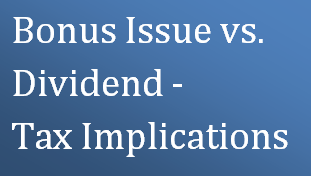
What is Dividend Distribution Tax (DDT)?
DDT is levied on companies @ 15% on the amount distributed as dividend to the shareholders of the company. Accordingly, a dividend-paying company first pays 30% income tax on its profits and then pays a 15% DDT on what it distributes to its shareholders out of its post-tax profits.
Example:
In a financial year, Company ‘A’ earns a net profit, of Rs.1000.
First, Company will pay income tax on this profit @30% i.e. Rs.300. Out of the post-tax profit of Rs.700 (Rs.1000 – Rs. 300), Company ‘A’ decides to distribute Rs.400 in dividends, and retain the remaining Rs.300 as reserves.
Before distributing Rs.400 as dividend, Company ‘A’ must pay a dividend distribution tax @ 15% i.e. Rs.60.
So how does the total transaction pan out in simple terms?
Let’s see the example for detailed information.
If the company decides to pay Rs.400, then it has to increase Rs. 400 in such a way that after paying tax @ 15%, dividend should be Rs. 400 in the hands of the shareholders.
To calculate the tax amount, use the formula below:
15% × (400+X) = X
X will be 70.59
For paying 400 as dividend, the company needs to pay Rs. 70.59 as DDT; therefore effective rate of tax on dividend comes out to 17.65%.
Note: For the purpose of this article DDT is calculated ignoring the surcharge and cess amount.
So the total transaction pans out as:
Company ‘A’: Rs.1, 000 (Profit) – Rs.300 (Income tax) – Rs.70.59 (DDT) – Rs.400 (Dividend) = Rs.229.41 transfer to Reserves.
Tax Authority: Rs.300 (Income tax) + Rs.70.59 (DDT) = Rs.370.59
Shareholders: Rs.400 on which no further tax is levied.
_____________________________
Note: Earlier Dividend Distribution Tax at the rate of 15% was computed with respect to the Net Amount paid as Dividend to the Investors. As the DDT was levied on the Net Amount Value instead of the Gross Amount Value, the effective rate of tax was lower than 15%.
The Finance Act 2014 has amended Section 115-O in which the dividends would be required to be grossed up for the purpose of payment of DDT.
Example on how DDT was calculated prior to the 2014 Amendment
Company ‘A’: Rs.1, 000 (Profit) – Rs.300 (Income tax) – Rs.60 (DDT) – Rs.400 (Dividend) = Rs.240 transfer to Reserves.
Tax Authority: Rs.300 (Income tax) + Rs.60 (DDT) = Rs.360
Shareholders: Rs.400 – Rs.60 = Rs. 340* on which no further tax is levied.
(*This Rs. 340 is divided by the number of shares to calculate per share dividend)
_____________________________
Bonus Issue – Bonus shares are issued by cashing in on the free reserves of the company. A company builds up its reserves by retaining part of its profit over the years (the part that is not paid out as dividend). After a while, when this free reserves increases, the company can issue bonus shares.
When a company declares a bonus issue, the investors get bonus shares in proportion to the number of shares they hold. After the bonus issue, the number of outstanding shares increases and the EPS falls by the same extent.
Also Read: Share Split vs. Bonus Issue – Impact on Shareholders
A 1:2 bonus means that a shareholder will get 1 share for every 2 shares that he holds. I.e. if you are holding 10 shares, you will get 5 bonus shares. You do not need to pay any tax to receive these bonus shares.
Benefit of Issuing Bonus Shares vs. Dividend
[1] Major Benefit | Tax Saving – In case of cash dividends, companies have to pay dividend distribution tax whereas in case of bonus shares, no dividend distribution tax is levied.
Bonus shares are treated as normal shares and tax implication only arises in case of short term capital gains (holding period less than 12 months) in the hands of investors/shareholders.
[2] As per the Companies Act 2013, “No dividend shall be declared or paid by a company for any financial year except out of the profits of the company for that year”.
Consider a situation where company has incurred a loss in a particular year. In such case, it cannot pay cash dividends but company can issue bonus shares. A bonus issue is also perceived by investors to be a strong signal by the company’s management of its readiness to service an enhanced shareholder base.

